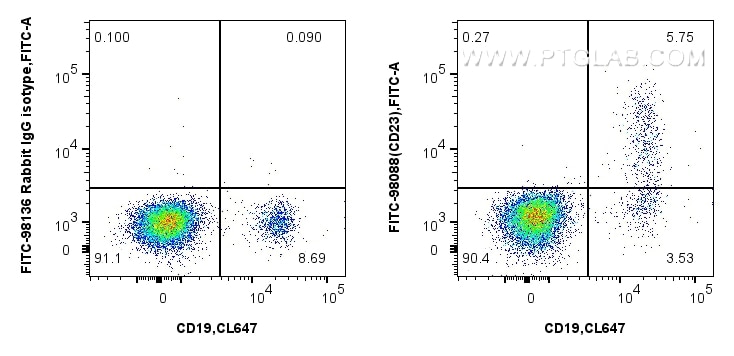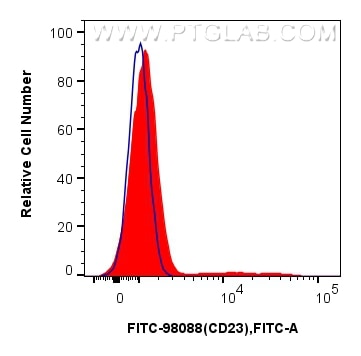Anticorps Recombinant de lapin anti-CD23
CD23 Recombinant Antibody for FC
Hôte / Isotype
Lapin / IgG
Réactivité testée
Humain
Applications
FC
Conjugaison
FITC Plus Fluorescent Dye
CloneNo.
241270C6
N° de cat : FITC-98088
Synonymes
Galerie de données de validation
Applications testées
| Résultats positifs en cytométrie | CMSP humaines, |
Dilution recommandée
| Application | Dilution |
|---|---|
| This reagent has been pre-titrated and tested for flow cytometric analysis. The suggested use of this reagent is 5 ul per 10^6 cells in a 100 µl suspension or 5 ul per 100 µl of whole blood. | |
| Sample-dependent, check data in validation data gallery | |
Informations sur le produit
FITC-98088 cible CD23 dans les applications de FC et montre une réactivité avec des échantillons Humain
| Réactivité | Humain |
| Hôte / Isotype | Lapin / IgG |
| Clonalité | Recombinant |
| Type | Anticorps |
| Immunogène | Protéine recombinante |
| Nom complet | Fc fragment of IgE, low affinity II, receptor for (CD23) |
| Masse moléculaire calculée | 321 aa, 36 kDa |
| Numéro d’acquisition GenBank | BC064417 |
| Symbole du gène | CD23 |
| Identification du gène (NCBI) | 2208 |
| Conjugaison | FITC Plus Fluorescent Dye |
| Excitation/Emission maxima wavelengths | 495 nm / 524 nm |
| Forme | Liquide |
| Méthode de purification | Purification par protéine A |
| Tampon de stockage | PBS with 0.09% sodium azide and 0.5% BSA |
| Conditions de stockage | Store at 2-8°C. Avoid exposure to light. Stable for one year after shipment. |
Informations générales
CD23, also known as low affinity immunoglobulin epsilon Fc receptor, is a transmembrane glycoprotein present on a subpopulation of B lymphocytes in germinal centres, EBV-transformed B-lymphoblastoid cell lines, follicular dendritic cells, and a subpopulation of peripheral blood cells. CD23 has essential roles in the regulation of IgE production and in the differentiation of B-cells.
Protocole
| Product Specific Protocols | |
|---|---|
| FC protocol for FITC Plus CD23 antibody FITC-98088 | Download protocol |
| Standard Protocols | |
|---|---|
| Click here to view our Standard Protocols |



